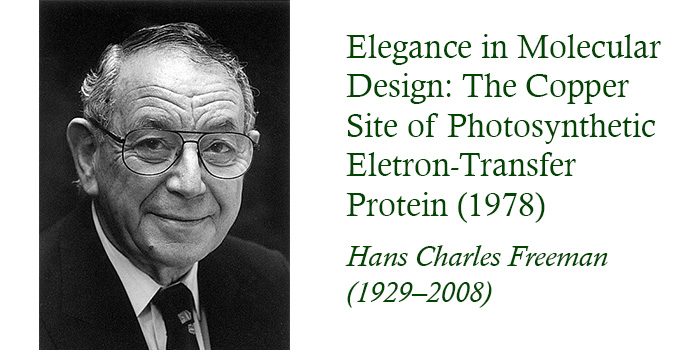21: Elegance in Molecular Design: The Copper Site of Photosynthetic Electron-Transfer Protein (1978)
Abstract
The Liversidge Research Lecture, delivered before the Royal Society of New South Wales, 19th July, 1978. Reproduced by permission of the Royal Society of New South Wales from J. Proc. Roy. Soc. N.S.W., 1979, 112, 45-62.
"Plastocyanin is an intensely blue protein which is essential for photosynthesis in green leaves and in some algae. The blue colour is associated with the presence of a single copper atom in each molecule of the protein. In terms of the absorbance per copper atom, plastocyanin is about a hundred times as blue as 'normal' cupric compounds. In addition, the protein has an unusual electron spin resonance spectrum and an anomalously high redox potential. The combination of these properties occurs in some other copper-proteins but has not yet been mimicked in any model compound of low molecular weight."
"The recent X-ray crystal structure analysis of plastocyanin has revealed a molecule ideally suited to the biological function which it performs. The nature of the copper site is such as to produce the high redox potential which is required for electron-transfer between plastocyanin and its neighbours in the photosynthetic chain. The location of the copper site in the protein molecule provides at least two reasonable electron-transfer pathways. The exterior of the molecule has distinctive features which suggest that the protein interacts in specific ways with its redox partners and/or its environment."
References
Acland, C.B., and Freeman, H.C., 1971. Chem. Commun. , 1016-1017.
Acland, C.B., Flook, R.J., Freeman, H.C. and Scudder, M. L., 1972. Acta Cryst., A28, S75-S76.
Beattie, J.K., Fensom, D.J., Freeman, H.C., Woodcock, E., Hill, H.A.O., and Stokes, A.M., 197S. Biochim. Biophys. Acta, 405, 109-114.
Billo, E.J., 1974. Inorg. Nucl. Chem. Lett., 10, 613-617.
Birker, P.J.M.W.L. and Freeman, H.C., 1977. J. Amer. Chem. Soc., 99, 6890-6899.
Boulter, D., Haslett, B.G., Peacock, D., Ramshaw, J.A.M., and Scawen, M.D., 1977. Int. Rev. Biochem., 13, 1-40.
Chapman, G.V., Colman, P.M., Freeman, H.C., Guss, ,J. M. , Murata, M. , Norris, V.A., Ramshaw, J.A.M., and Venkatappa, M.P., 1977a. J. Mol. Biol., 110, 187-189.
Colman, P.M., Freeman, H.C., Guss, J.M., Murata, M., Norris, V.A., Ramshaw, J.A.M., Venkatappa, M.P., and Vickery, L.E., 1977b. J. Mol. Biol., 112, 649-650.
Colman, P.M., Freeman, H.C., Guss, J.M., Murata, M., Norris, V.A., Ramshaw, J.A.M. and Venkatappa, M.P., 1977c. In Photosynthesis 77: Proceedings of the Fourth International Congress on Photosynthesis (Eds. Hall, D.O., Coombs, J. & Goodwin, T.W.), 809-813. (Biochemical Society, London).
Colman, P.M., Freeman, H.C., Guss, J.M., Murata, M., Norris, V.A., Ramshaw, J.A.M. and Venkatappa, M.P., 1978. Nature, 272, 319-324.
Freeman, H.C., 1967. Advanc. Prot. Chem., 22, 257-424
Freeman, H.C. Norris, V.A., Ramshaw, J.A.M., and Wright, P.E., 1978. FEBS Lett., 86, 131-135.
Gould, D.C. and Ehrenberg, A., 1968. Eur. J. Biochem., 5, 451-455.
Hare, J.W., Solomon, E.I., and Gray, H.B., 1976. J. Amer. Chem.Soc., 98, 3205-3209.
James, B.R. and Williams, R.J.P., 1961. J. Chem. Soc., 2007-2019.
Jones, T.E. Rorabacher, D.B. and Ochrymowicz, L.A., 1975. J. Amer. Chem. Soc., 99, 6730-6739.
Markley, J. K. , Ulrich, F. L. , Berg, S. P. and Krogmann, D.W., 1975. Biochemistry, 14, 4428-4433.
Milne, P.R. and Wells, J.R.F., 1970. J. Biol. Chem., 245, 1566-1574.
Miskowski, V. Tang, S.P.W., Spiro, T.G., Shapiro, E. and Moss, T.H., 1975. Biochemistry, 14, 1244-1250.
Siiman, O., Young, N.M. and Carey, P.R., 1976. J. Amer. Chem. Soc., 98, 744-748.
Solomon, E.I., Clendening, P.J., Gray, H.B. and Grunthaner, F.J., 1975. J. Amer. Chem. Soc., 97, 3878-3879.
Solomon, E. I., Hare, J. W. and Gray, H. B., 1976. Proc. Natl. Acad. Sci. U.S.A., 73, 1389-1393.
Ugurbil, K., Norton, R.S., Allerhand, A. and Bersohn, R., 1977. Biochemistry, 16, 886-894.
Vallee, B.L. and Williams, R.J.P., 1968. Proc. Natl. Acad. Sci., USA., 59, 498-505.

